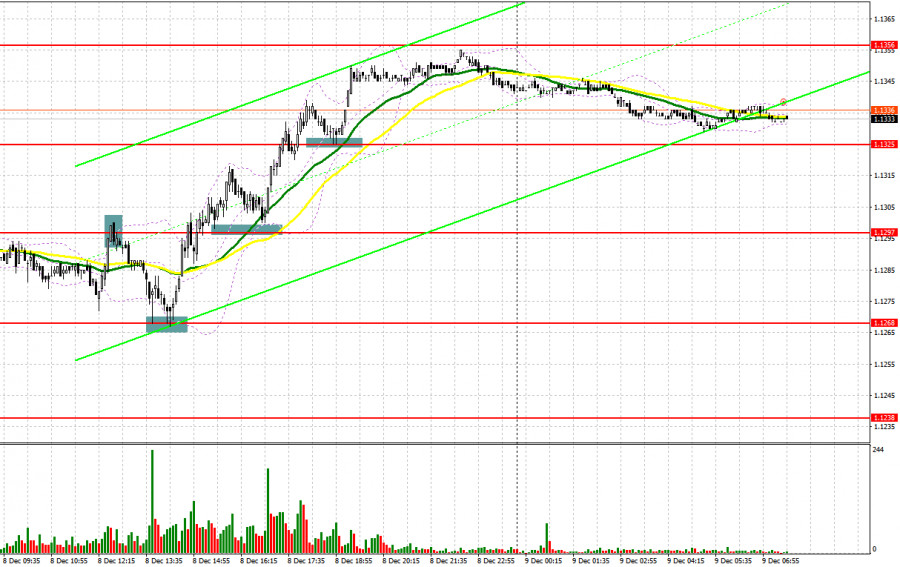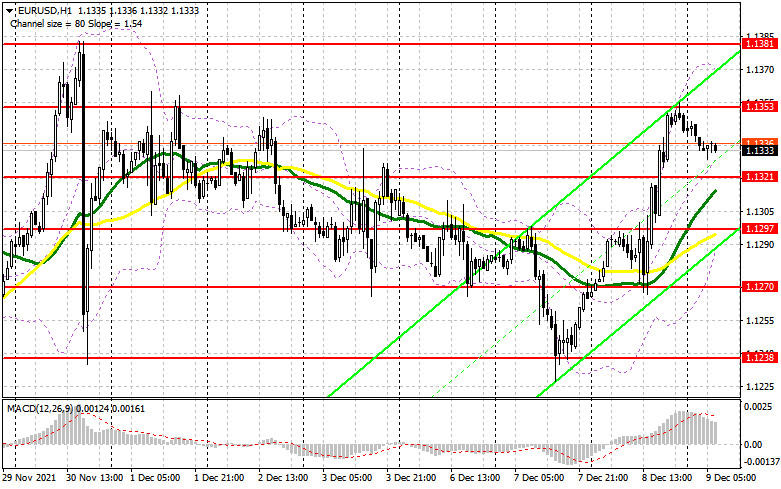To open long positions on EUR/USD, you need:
Yesterday there were no signals to enter the market in the first half of the day, which cannot be said about the US session. Let's take a look at the 5 minute chart and talk about what happened. Formation of a false breakout at the level of 1.1297 and failure to settle above - all this led to a signal to sell the euro, after which the pair dropped 30 points. The bulls were active and managed to protect the support of 1.1268, where a false breakout has already given a buy signal. The statements by the representatives of the European Central Bank and the inauguration of the new German chancellor had a positive impact on consumer sentiment, which led to the euro's growth by more than 90 points in the afternoon. A breakthrough and consolidation above 1.1297 formed an excellent entry point into long positions. A similar buy signal was formed after going beyond 1.1325.

Today's news on the eurozone is hardly surprising, since there are practically none. All this preserves the chance for the euro's succeeding growth in the short term. Good data on the growth of Germany's foreign trade surplus will strengthen investor confidence in the future of the economy, which will positively affect the euro bulls. This could lead to a breakthrough and consolidation above 1.1353, which was not done yesterday. A test of this level from top to bottom will provide an excellent entry point into buying the euro with the goal of returning to the area of a rather large high like 1.1381, which acts as the upper border of a wide horizontal channel - the pair has been in it since November 30. Its breakdown can seriously affect the EUR/USD downward trend, so be very careful at this level. A break and a downside test of 1.1381 would see a larger advance towards the highs of 1.1415 and 1.1442. The next target will be the 1.1480 level, where I recommend taking profits. There is no need to panic if the euro is under pressure in the morning. On the contrary, a decline could create more convenient entry points into long positions. Formation of a false breakout at 1.1321, just below which the moving averages pass, will provide a good entry point into long positions. If the bulls are not active at this level, it is best to postpone selling until the larger support at 1.1297. I advise you to buy EUR/USD immediately on a rebound from the 1.1270 low, or even lower - in the area of 1.1238 while aiming for an upward correction of 20-25 points within the day.
To open short positions on EUR/USD, you need:
The bears received a pretty strong rebuff and now a lot depends on their actions near important resistance levels. The main task for the first half of the day is to defend 1.1353, which we didn't manage to get beyond yesterday. Only the formation of a false breakout there, together with weak data on the balance of foreign trade in Germany, will lead to an excellent entry point into short positions, hoping to keep the pair at least in a horizontal channel, as a high - to return the bearish momentum. The news about the new Omicron strain does not work as well on the markets, as its negative consequences turned out to be less dangerous. Therefore, an equally important task for the EUR/USD bears is to regain control over the support at 1.1321, just below which are the moving averages playing on the bulls' side. You can act by analogy with yesterday, only in the opposite direction: a breakthrough and a test from the bottom up at 1.1321 will lead to forming a signal to open short positions with the prospect of a decline to the 1.1297 area. The next target will be support at 1.1270, where I recommend taking profits. In case the euro grows and the bears are not active at 1.1353, it may well be that the bears will release the market for a larger entry from the "last hope" - the 1.1381 level. The optimal scenario will be short positions when a false breakout is formed in the 1.1381 area. Selling EUR/USD immediately on a rebound is possible from highs: 1.1415 and 1.1442 while aiming for a downward correction of 15-20 points.

I recommend for review:
The Commitment of Traders (COT) report for November 30 revealed a decrease in both short and long positions. However, the reduction of long positions still remained higher, which led to an increase in the negative delta. Last week there were a lot of speeches by Federal Reserve Chairman Jerome Powell, who in his comments spoke enough about the expected changes in monetary policy towards its tightening. The reason for this is rather high inflation, which has grown from "temporary" to permanent, which creates many problems for the central bank. The second problem was a new strain of the Omicron coronavirus, which will slow down the global economy at the end of this and early next year, which also restrains the demand for risky assets from bulls. The Fed will hold a meeting next week, at which a decision will be made on the bond purchase program, so demand for the US dollar is expected to remain in the shorter term. The latest November COT report indicated that long non-commercial positions declined from the level of 204,214 to the level of 191,048, while short non-commercial positions fell from the level of 220,666 to the level of 214,288. At the end of the week, the total non-commercial net position increased to -23,240 against -16,452. The weekly closing price, on the contrary, rose much to 1.1292 against 1.1241.
Indicator signals:
Trades above the 30 and 50 day moving averages, which indicates an attempt by bulls to regain the position of the market.
Moving averages
Note: The period and prices of moving averages are considered by the author on the H1 hourly chart and differs from the general definition of the classic daily moving averages on the daily D1 chart.
Bollinger Bands
In case of a decline, support will be provided by the lower border of the indicator in the area of 1.1290. In case of growth, the upper border of the indicator at 1.1370 will act as a resistance.
Description of indicators
- Moving average (moving average, determines the current trend by smoothing out volatility and noise). Period 50. It is marked in yellow on the chart.
- Moving average (moving average, determines the current trend by smoothing out volatility and noise). Period 30. It is marked in green on the chart.
- MACD indicator (Moving Average Convergence/Divergence — convergence/divergence of moving averages) Quick EMA period 12. Slow EMA period to 26. SMA period 9
- Bollinger Bands (Bollinger Bands). Period 20
- Non-commercial speculative traders, such as individual traders, hedge funds, and large institutions that use the futures market for speculative purposes and meet certain requirements.
- Long non-commercial positions represent the total long open position of non-commercial traders.
- Short non-commercial positions represent the total short open position of non-commercial traders.
- Total non-commercial net position is the difference between short and long positions of non-commercial traders.











